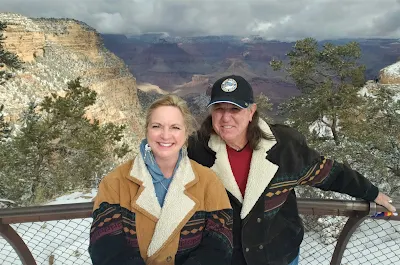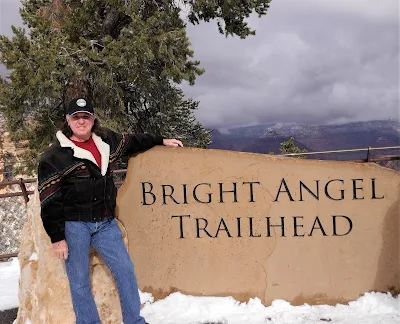“You know,” Laureen said, “It would be nice to have some fresh orange juice for breakfast.”
I nodded. “And I know just the place.”
In a little over an hour, we were at the California Citrus State Historic Park, in Riverside.
.JPG) |
| One of the paths through a citrus grove at the park |
“Yes, but you wanted fresh oranges and here we are,” I replied.
Hundreds and hundreds of green-leafed trees budding with voluptuous oranges beckoned us to pick them. We would have our fill with the vitamin C fruits.
The Ranger at the small toll gate smiled and told us we could not use drones over the vast fields of orange trees.
“No flying drones, got it,” I replied.
“Also, you can not pick any of the oranges in the park.”
“Isn’t this an orange park with a lot of oranges?” I asked.
“It is a state historical park, no picking of the fruit,” she said.
“Are the oranges historical?”
Both Laureen and the Ranger rolled their eyes at me.
An orange tree park where a visitor can not imbibe on such a delicious snack as an orange seemed odd to me.
‘Welcome to San Onofre State Beach, where no swimming, boating, or fishing is allowed.’
‘Welcome to Heart Bar State Park, where no hiking or camping is allowed.’
Research indicated that under California Code Regulations, Title 14 (a) – no person shall willfully or negligently pick, dig up, cut, mutilate, destroy, injure, or do any other bad stuff to any tree, plant, or portion of. . .
Okay, so we would not pick any fruit. It was still a beautiful location to spend an early morning walking through the groves and just taking in nature at its best.
I grew up in Riverside. Did not leave until my third decade on this revolving ball we call Earth. Return visits were many to visit family, but those visits became less and less frequent as family became smaller through the years.
Having spent a lot of time riding horses through the vastness of orange tree tracts with my school friend, Michael, this visit brought back great memories. Galloping here and there up and down Victoria Avenue throwing clods of dirt into the air was a lot of fun. Unless an errant orange tree branch would remove me from the saddle, which took the fun away rather quickly.
.JPG) |
| John R Beyer enjoying a respite at the citrus park |
In 1871, Eliza Tibbets had received three Brazilian navel orange trees from a friend of hers, William Saunders. Turned out, Saunders worked for the United States Department of Agriculture in Washington D.C., and he believed the citrus would grow well in the semi-arid climate for which Riverside is known.
His assumption was correct, and the trees took off like a wildfire. No, that would have destroyed them. Instead, the Brazilian orange trees grew very well and very rapidly.
It was rumored that Saunders was so thrilled, that he danced the Bumba Meu Boi while sipping on a Caipirinha at the same time.
Of the original three trees, two survived and were transplanted from Tibbet’s property to a safer location at Sam McCoy’s, who would watch over them a bit more carefully. A cow stomped on one of the three trees killing it while under Tibbet’s care.
Talk about freshly squeezed.
The two remaining survivors of the infamous cow stampede were transplanted again, one at the Mission Inn and the other at the intersection of Magnolia and Arlington avenues.
President Theodore Roosevelt paid homage to the tree at the Mission Inn during a visit to Riverside in 1903. It is rumored he plucked a big fat juicy orange and ate it right there on the flagstone patio.
That tree died in 1922, but the last of the three trees is still growing strong at the intersection of Magnolia and Arlington. Though there is a large fence around it to keep people from being tempted to eat the oranges which grow in bushels upon its branches.
Oranges were such a huge financial success that by 1882, of the more than a half million citrus trees in the state of California, half were in Riverside. With the vast improvement in refrigerated railroad cars during the 1880s, growers had the chance to transport the citrus eastward, and Riverside became the richest city, per capita, in the United States by 1895.
Within the visitor center at the California Citrus State Historic Park is a large museum which has a plethora of information from the beginning to the current day dealing with this business of citrus. There are models of packing houses, wooden crates, photographs of the original complexes, photographs of people who worked the groves – along with their personal stories, a detailed history of the orange industry, farm implements, and much more for the curious citrus history visitor.
.JPG) |
| The visitor center at the California Citrus State Historic Park |
.JPG) |
| Just some of the farming equipment on display |
.JPG) |
| One of a few pagodas in the park |
.JPG) |
| Venue center at the California Citrus State Historic Park |
Before there was a Riverside County, the lands were the homes to the Native American tribes, Serrano, Luiseno, Cahuilla, Cupeno, and others. When the citrus industry started, many of these natives worked for the growers but due to government policies and racial prejudices the workforce declined causing harsh living conditions for the natives. In 1903, with the Sherman Indian Institute coming into existence in Riverside, a new work program allowed students to return working for the growers, which they did as late as the 1930s. Though the students were working, they were working in poor conditions and for very little pay. What seemed like a good idea at the time only provided cheap labor for a large money-making industry.
Chinese immigrants were employed when the Native American workforce dwindled, and by 1885 nearly eighty percent of the workers were Chinese. The Chinese Exclusion Act of 1882 finally reached its ugly head in the Riverside area and suddenly the Chinese workers were no longer wanted. In came the Japanese immigrants who, by 1900, made up most of all workers in the groves. But again, local resentment of the Asian immigrants made their numbers fall to a low in 1920, when Hispanic immigrants moved in and took up the slack of workers.
Like all history, there is good and there is bad – thus there is a need to study it and the museum does a wonderful service explaining the importance and how dependent the industry was on all the various peoples who built such an agricultural phenomenon.
Some of the stories a visitor will learn are heart breaking but at the same time those stories express tales of such strong-willed individuals. These folks toiled day in and day out to make America what it is today. They were incredible people.
It is always worth remembering and appreciating their personal sacrifices.
With well over two hundred acres of land to wander over, there is a lot to see, and it is not just oranges that grow within the park grounds. Nope, there are grapefruit, lemons, and avocados growing everywhere. And there are special types of citrus and other plants along the exterior walking paths which would pique the interest of any serious botanist.
There are also some plants with rather unusual and intriguing names: the Australian Finger Lime, the Sticky Monkey Flower, the Mulefat, the Royal Beard Tongue, and many more to marvel at during a leisurely stroll. Though, I’m not sure any should be touched, no matter what the California laws dictate about doing so, but with names like those, who knows what could happen.
I do recall Harry Potter and the rather poisonous Pomona Sprout’s Garden. Don’t want to be accidently turned into a newt, now do we?.JPG) |
| An original growers abode |
.JPG) |
| Beautiful views of the mountains from the park |
.JPG) |
| A section of the Gage Canal |
I have told Laureen and my children of those memories. They smile and nod their heads – they are good like that. But when I visited the California Citrus State Historic Park, personal memories of my childhood in Riverside flooded back – and it was nice.
For further information - https://www.parks.ca.gov/?page_id=649







